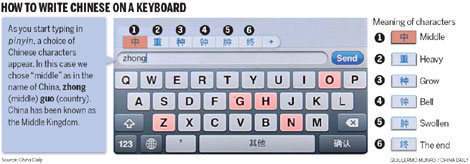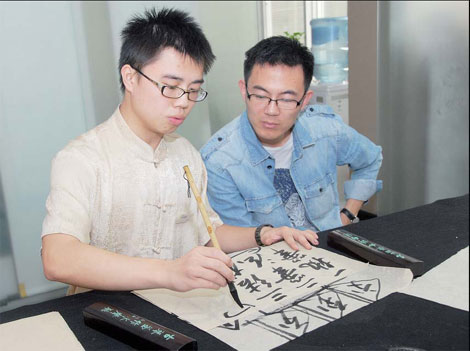Test of character
Updated: 2011-09-23 09:11
By Lin Jing (China Daily)
|
|||||||||
|
|
Keyboard-dependent Chinese are returning to school because they have forgotten how to write
Zhang Guangbing cannot remember the last time he penned a hand-written letter, or even wrote Chinese characters on paper. "Probably when I was still in the university, about five years ago, working on my final exams," the 28-year-old man recalls vaguely.
Zhang works as a financial assistant at a State-owned enterprise and his daily work includes producing diagrams and calculation sheets on a computer using a keyboard and a mouse. Communication with family and friends is conducted through all kinds of electronic channels, such as MSN, email or cell phone.
"I barely write anything since I started work. For me, pens are more often used to make marks. The structures and stokes of Chinese characters seem so vague in my mind," he says
Zhang is part of a new Chinese generation that is struggling to write because of the widespread use of emailing and text messaging.
The pen is no longer needed.
When writing Chinese on a keyboard, the user types the word using pinyin, which is a phonetic system of writing using the Roman alphabet, then a selection of different characters are displayed on screen. The same pinyin word has many different meanings in Chinese so the user then selects the relevant character (see graphic).
A recent online survey conducted by Tencent, a Chinese Internet portal, revealed that about 55 percent of tech-savvy netizens have trouble writing Chinese characters. About 30 percent say they have forgotten many characters when using a pen while 25 percent say their standard is very sloppy.
Experts blame the popularity of electronic appliances.
"Because of the wide usage of electronic equipment in the past decade, the general handwriting level has retrograded," says Tian Boping, secretary-general of the Beijing Calligraphers' Association.
Tian says the promotion of a paperless office has also helped to popularize keyboards but despite environmental benefits, he still has cultural concerns.
"Your handwriting is like your namecard and is your personality. In Chinese we have a saying, 'the writing style is the man'. Beautiful handwriting is a fine illustration of your education and culture," he says.
Shen Hongyu, an independent calligrapher from Zhengzhou, Henan province, says the most urgent issue in schools is the lack of systematic writing classes.
"At present, very few schools have included calligraphy classes in their curriculum though there is a great need from students and parents," says Shen.
Zhou Ran, a primary school teacher in Suqian, Jiangsu province, says fewer than 20 pupils of her 63-student class are able to write neatly. "Parents are also very concerned about the awful handwriting of their children, and some of them even take their kids to tutorial classes after school," Zhou says.
This month, the Ministry of Education issued a regulation ordering primary schools hold at least one calligraphy class every week for students. According to this new rule, primary school students below fourth grade should master writing in regular script and pick up brush-writing gradually.
Shen, who has studied calligraphy for 15 years, says education is a good start and may raise social awareness. But improving the level of handwriting across the wider public will require a long-time effort.
"We should teach people the importance and beauty of handwriting. For instance, in the roadside advertisements and big board on buildings, we should use handwriting characters instead of those made by computer."
Some forward-looking companies see the fall in writing skills as a business opportunity. Hanxiang Shufa, a franchised calligraphy training school based in Beijing, is one of them. Since its establishment in 2009, the company has set up seven training schools, four in Beijing and three in other provinces.
"Nowadays people blame the popularity of electronic products for their impaired handwriting, but I think the basic reason is the ignorance of Chinese culture and the tendency of pragmatism," says Li Xiaoya, CEO of Hanxiang. "For the older people, born in the 1930s, even without a lot of educational background, they can still write beautiful characters in their letters."
To master calligraphy, a beginner needs three years' intensive training but Hanxiang has developed a 24-hour writing course, which will help people master the basics.
Classes range from 3,000 yuan (343 euros) to 50,000 yuan and the course has received positive feedback, says Li. Currently the school has about 1,000 students, both adults and children.
Li, a member of the post-80s generation, says calligraphy and technology mix. "More people are becoming reliant on typing. But these two things are not and should not be incompatible as fire and water."
On the contrary, she says, the best way to promote calligraphy and handwriting is to combine the old art with new technologies.
"The company is also working on a new app for iPhone and iPad, teaching people the structure and some basics in calligraphy."
"We are trying to save this Chinese traditional element with the help of the new technologies. There is still a lot room for imagination in this field."

(China Daily 09/23/2011 page18)











